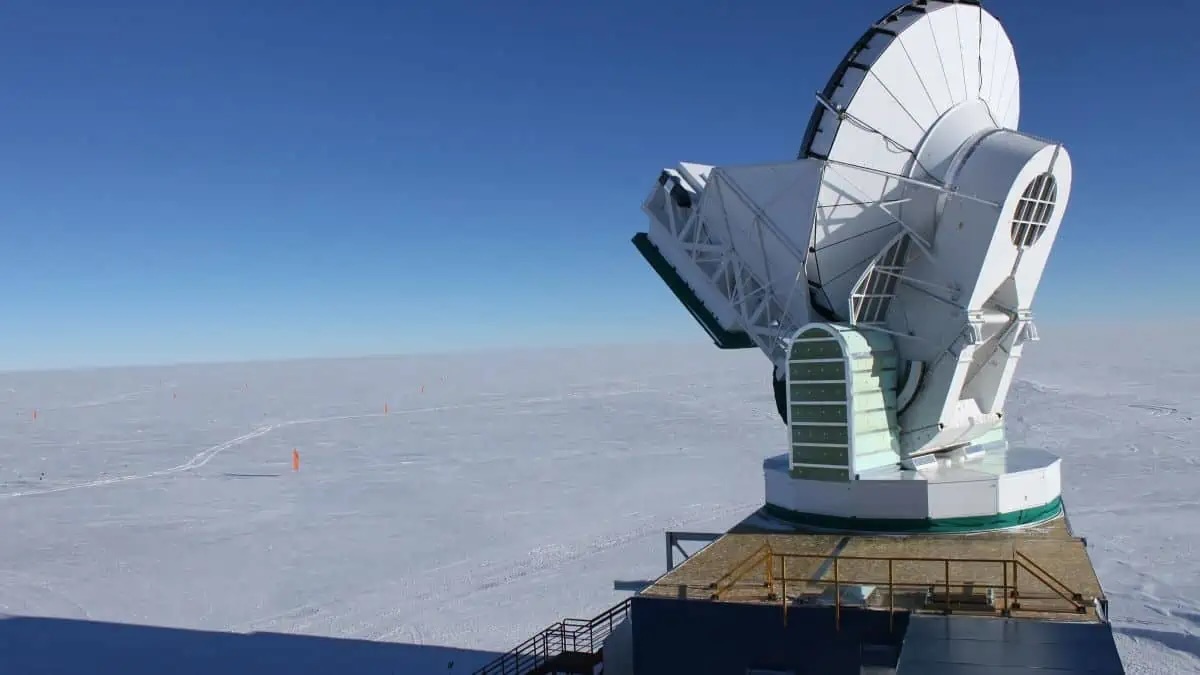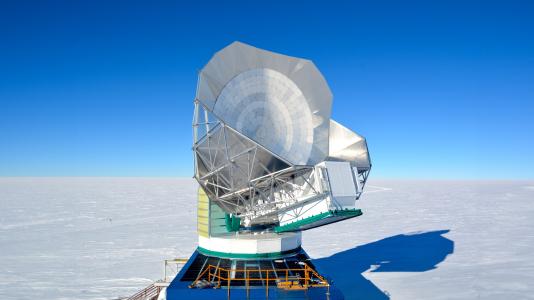10.02.2024

The South Pole Telescope. Credit: Eli Duke/Flicker/CC BY 2.0 DEED
At the Amundsen–Scott South Pole Station in Antarctica sits a large telescope. Its purpose is to understand the faint hum of microwave light across the Universe, left over from the afterglow of the Big Bang.
Researchers who have just published the results of their work in Physical Review D, haven’t found any physics-breaking results, and they’re delighted – for now Einstein’s theory of relativity will hold.
“We found that the observed lensing patterns in this study are well explained by general relativity,” said Zhaodi Pan, a researcher at the US’s Department of Energy’s Argonne National Laboratory.
“This suggests that our current understanding of gravity holds true for these large scales. The results also strengthen our existing understanding of how structures of matter formed in our universe.”
The telescope was upgraded in 2017 with a new camera called SPT-3G. This camera – which has 16,000 detectors – is measuring the Cosmic Microwave Background (CMB), the afterglow of microwave light left over from the Big Bang.
“The CMB is a treasure map for cosmologists,” said Pan. “It’s minuscule variations in temperature and polarization provide a unique window into the universe’s infancy.”
But there’s another part here too – gravitational lensing. Think of this like staring at a rock through water at the beach – the water distorts and warps the light before it reaches your eyes. In the same way, matter like black holes and large galaxies warps light from the CMB before it reaches the telescopes.
Parkes Telescope: gravitational waves discovery 18 years in the making
This warping in the fabric of space-time is part of Einstein’s general relativity.
This study is just looking at data from 2018, but so far they found that while looking at a large part of the Southern Sky, the rate of gravitational lensingwas close to what general relativity would expect.
“One of the really exciting parts of this study is that the result comes from what’s essentially commissioning data from when we were just beginning observations with the SPT-3G — and the result is already great,” said Amy Bender, a physicist at Argonne.
“We’ve got five more years of data that we’re working on analysing now, so this just hints at what’s to come.”
Quelle: COSMOS
+++
Results from South Pole Telescope’s new camera emerge
Gravitational lensing maps from initial data promise even more detail

For more than five years, scientists at the South Pole Telescope in Antarctica have been observing the sky with an upgraded camera. The extended gaze toward the cosmos is picking up remnant light from the universe’s early formation. Now researchers have analyzed an initial batch of data, publishing details in the journal Physical Review D. The results from this limited dataset hint at even more powerful future insights about the nature of our universe.
The telescope at the Amundsen-Scott South Pole Station, which is operated by the National Science Foundation, received a new camera known as SPT-3G in 2017. Equipped with 16,000 detectors — 10 times more than its predecessor — the SPT-3G is central to multi-institutional research led in part by the U.S. Department of Energy’s (DOE) Argonne National Laboratory. The goal is to measure faint light known as the cosmic microwave background (CMB). The CMB is the afterglow of the Big Bang, when the universe burst forth from a single point of energy nearly 14 billion years ago.
“The CMB is a treasure map for cosmologists,” said Zhaodi Pan, the paper’s lead author and a Maria Goeppert Mayer fellow at Argonne. “Its minuscule variations in temperature and polarization provide a unique window into the universe’s infancy.
The paper in Physical Review D offers the first CMB gravitational lensing measurements from the SPT-3G. Gravitational lensing happens when the universe’s vast web of matter distorts the CMB as it travels across space. If you were to place the curved base of a wine glass on the page of a book, the glass would warp your view of the words behind it. Similarly, matter in the telescope’s line of sight forms a lens that bends the CMB light and our view of it. Albert Einstein described this warping in the fabric of space-time in his theory of general relativity.
“The CMB is a treasure map for cosmologists. Its minuscule variations in temperature and polarization provide a unique window into the universe’s infancy.” — Zhaodi Pan, Maria Goeppert Mayer fellow at Argonne
Measurements of that distortion hold clues about the early universe and mysteries like dark matter, an invisible component of the cosmos. “Dark matter is tricky to detect, because it doesn’t interact with light or other forms of electromagnetic radiation. Currently, we can only observe it through gravitational interactions,” Pan said.
The cosmic microwave background — the universe’s oldest light — has traversed vast distances before reaching us. During its extended journey, gravitational forces from massive cosmic structures caused its trajectory to bend before being captured by the South Pole Telescope. (Image by Zhaodi Pan/Argonne National Laboratory.)
Scientists have been studying the CMBever since it was discovered in the 1960s, observing it through telescopes both on the ground and in space. Even though the newest analysis uses only a few months of SPT-3G data from 2018, the measurement of gravitational lensing is already competitive in the field.
“One of the really exciting parts of this study is that the result comes from what’s essentially commissioning data from when we were just beginning observations with the SPT-3G — and the result is already great,” said Amy Bender, a physicist at Argonne and paper co-author. “We’ve got five more years of data that we’re working on analyzing now, so this just hints at what’s to come.”
The dry, stable atmosphere and remote location of the South Pole Telescope create as little interference as possible when hunting for CMB patterns. Still, data from the highly sensitive SPT-3G camera contains contamination from the atmosphere, as well as from our own galaxy and extragalactic sources. Analyzing even a few months of data from SPT-3G is an undertaking that lasts years, since researchers need to validate data, filter out noise and interpret measurements. The team used a dedicated cluster, a group of computers, at the Argonne Laboratory Computing Resource Center to run some of the calculations for the research.
“We found that the observed lensing patterns in this study are well explained by general relativity,” Pan said. “This suggests that our current understanding of gravity holds true for these large scales. The results also strengthen our existing understanding of how structures of matter formed in our universe.”
SPT-3G lensing maps from additional years of data will also help in probing cosmic inflation, or the idea that the early universe underwent a fast exponential expansion. Cosmic inflation is “another cornerstone of cosmology,” Pan noted, and scientists are hunting for signs of early gravitational waves and other direct evidence of this theory. The presence of gravitational lensing introduces interference with inflationary imprints, necessitating the removal of such contamination, which can be calculated using precise lensing measurements.

In this scaled matter distribution for all the matter in the observable universe, measured by SPT-3G, red indicates areas of higher matter density, while blue indicates lower density. (Image taken from the team’s Physical Review D paper..)
While some results from the new SPT-3Gdata will reinforce existing knowledge, others will raise new questions.
“Every time we add more data, we find more things that we don’t understand,” Bender said who holds a joint appointment at the University of Chicago. “As you peel back layers of this onion, you learn more and more about your instrument and also about your scientific measurement of the sky.”
So little is known about the universe’s unseen components that any understanding gained is critical, Pan said: “The more we learn about the distribution of dark matter, the closer we get to understanding its nature and its role in forming the universe that we live in today.”
This work was funded by the National Science Foundation’s Office of Polar Programs and the DOE Office of Science’s High Energy Physics program. The scientific analysis was led by Pan, in close collaboration with lead co-authors W. L. Kimmy Wu and Federico Bianchini (SLAC National Lab) and the SPT-3G collaboration. Argonne-affiliated co-authors with Bender and Pan are Lindsey Bleem, Karen Byrum, John Carlstrom, Faustin Carter (Argonne alumnus), Thomas Cecil, Clarence Chang, Junjia Ding (Argonne alumnus), Riccardo Gualtieri (Argonne alumnus), Angelina Harke-Hosemann (Argonne alumnus), Jason Henning (Argonne alumnus), Florian Kéruzoré, Trupti Khaire (Argonne alumnus), Steve Kuhlmann, Valentine Novosad, John Pearson, Chrystian Posada (Argonne alumnus), Gensheng Wang and Volodymyr Yefremenko.
Quelle: Argonne National Laboratory
